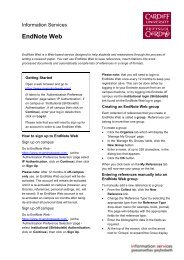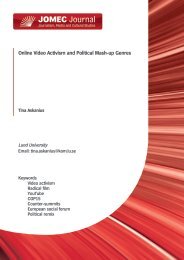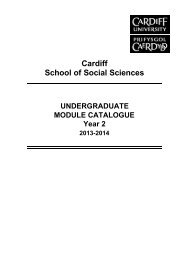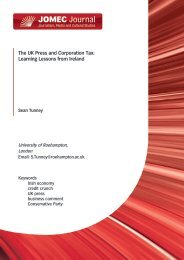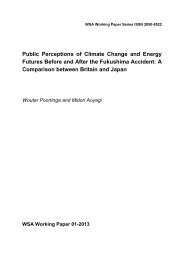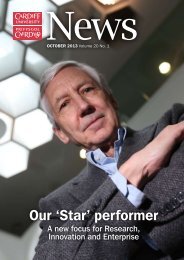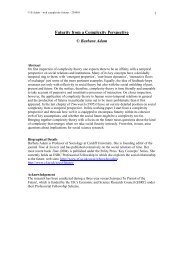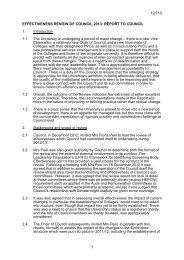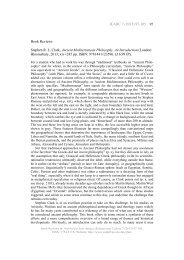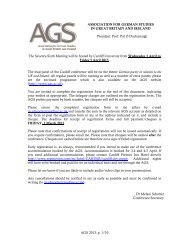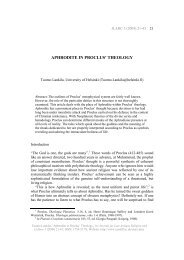Catherine's essay - Cardiff University
Catherine's essay - Cardiff University
Catherine's essay - Cardiff University
You also want an ePaper? Increase the reach of your titles
YUMPU automatically turns print PDFs into web optimized ePapers that Google loves.
Where Are The Women?<br />
Are women systematically excluded from the political process?<br />
The relationship between feminism and the political process is one that is intricate, multifaceted<br />
and often fraught (Squires, 2006). Despite sharing similar preoccupations – that of<br />
rights, of representation and of participation – feminist scholars maintain that access to<br />
participatory, liberal democracy remains restricted for large percentages of the population<br />
(Phillips, 1991). Although the degree to which this is true varies, it is acknowledged that<br />
globally, women do not participate politically to the same extent as men (Kittilson and<br />
Schwindt-Bayer, 2012). Whilst the breadth of this discourse is too large to include within one<br />
<strong>essay</strong>, it is possible to identify a trend from the deconstruction of this phenomenon. This<br />
trend is deftly summed up by feminist theorists Susan Bourque and Jean Grossholtz:<br />
“The politics is a man’s world is a familiar adage; that political science as a discipline<br />
tends to keep it that way is less well accepted, but perhaps closer to the truth.”<br />
(Bourque and Grossholtz, 1974, cited by Phillips 2001, pp. 225)<br />
This <strong>essay</strong> will examine the validity of the claim that women are misrepresented within<br />
political theory and, as a result, marginalised in the political process.<br />
That politics is primarily regarded as a ‘male’ pursuit is widely recognised within academic<br />
literature. Heather Savigny and Lee Marsden (2011) explain that certain traits are valued by<br />
Western political culture: rationality, calculation, aggression, autonomy and leadership. In<br />
order to participate in political leadership, one must display these qualities regardless of<br />
whether one is male or female. However, they emphasise that the characteristics synonymous<br />
with political leadership are also those that are regarded as ‘male.’ Traits such as dominance,<br />
decisiveness and shrewdness stand diametrically opposed to the more ‘female’ traits such as<br />
passivity, sensitivity and nurturing.<br />
This construction of masculinity and femininity is a crucial point. Judith Butler (1990) neatly<br />
describes this in her book Gender Trouble, explaining that whilst one’s sex has certain fixed<br />
characteristics, the construction of one’s gender – how ‘male’ one is or how ‘female’ one is –<br />
is a social construct that is independent of biological constraint. The wider ramifications of<br />
this are also impossible to contain within one <strong>essay</strong>. They are included here as a means by<br />
which to frame Savigny and Marsden’s explanation of political behaviour. In order to<br />
participate in political leadership, women must cast off their constructed femininity and adopt<br />
a more masculine persona. Douglas Ponton (2010) considers the case of Margaret Thatcher.
He argues that she adopted strategies to accentuate her physical femininity, such as her<br />
hairstyle. However, her manner, her persona and even her speaking voice were carefully<br />
constructed to take on a more ‘masculine’ identity.<br />
The propagation of gendered behaviour traits is a keystone for Simone de Beauvoir’s theories<br />
regarding power and gender identity. In The Second Sex (1949), Beauvoir describes how<br />
women have been systematically constructed as secondary to male dominance – the ‘Other’<br />
as she describes it. By virtue of biology and historical materialism and aided by contributions<br />
from the arts, literature, science and politics, Beauvoir argues that being ‘male’ has been<br />
established as the norm, and as the ideal. As a logical progression, ‘female’ can only exist in<br />
relation to this and is therefore secondary. This is an assumption that can be traced back to<br />
the political philosophy of Aristotle, widely regarded as the foundation of Western political<br />
culture (Green, 1993).<br />
The consequences of this are explained by Gayle Leatherby (2003). This construction of the<br />
female as ‘the Other’ is exacerbated by a society built on a posteriori knowledge acquired by<br />
men, leading to a patriarchy, by which we mean the assumption that masculinity is more<br />
suited to the task than femininity, within all academic areas of the arts, media, literature,<br />
science and social sciences. Rosi Braidotti (2003) claims that in exposing the construction of<br />
women as ‘the Other,’ Beauvoir has exposed the fallacy that the accepted philosophical<br />
thinking is universal. She demonstrates that what is considered the norm is in fact patriarchal.<br />
Beauvoir was not the first to examine this form of patriarchy. In his work The Subjection of<br />
Women (1896), John Stuart Mill not only acknowledges the presence of patriarchal structures,<br />
but describes them as a legal subordination that is reprehensible. Mill posits that equilibrium<br />
between men and women exists in theory alone. It has never been put into practice. Since<br />
patriarchal society remains uncontested, it logically follows that patriarchy as the ideal is<br />
nothing but a theory and is not based on reasoned debate or argument. He asserts that<br />
patriarchy is the natural result of the law of force, in which physical strength equates to<br />
power. Mill argues that, if this is so, it is not only an assault on reason but as distasteful as<br />
slavery and as racism. The assumption that certain people cannot do certain things is one that<br />
is fallible and “if we accept this, we ought to act as if we believe it” (p.225).<br />
Feminism and politics remain separate, if interlinking, disciplines. Kristie McLure (1992)<br />
acknowledges that feminism has failed to produce a proliferation of opportunities for women
in male-dominated areas. She explains this by stating that, within the discipline of political<br />
science, ‘feminism’ indicates an interest in the divergence between the accepted genders. It<br />
does not, in itself, point to a singular struggle or acknowledge the wide array of perspectives<br />
that have since opened up. Jane Sawicki (1991) explains that it is insufficient to ask “What do<br />
women want?” as this question encapsulates a diverse set of intersections between race, class,<br />
age and culture. As Valerie Bryson (1992) puts it, whilst alienation is experienced on all<br />
political levels, it is unsatisfactory to compare the alienation experienced by liberated, white<br />
American women with the alienation experienced by disenfranchised black American<br />
women. This is a level of inequality that is not necessarily included in political research.<br />
Bourque and Grossholtz (1974) frame the argument thusly: that the undertaking of data<br />
analysis by predominantly white, affluent males has resulted in political activity consequently<br />
taking on a persona that reflects a Western social construction of masculinity. This is turn has<br />
grouped all other marginalised persons together and concludes that they are politically<br />
disempowered of their own volition. They examine three studies regarded as seminal and<br />
quoted widely (These being The American Voter, Angus Campbell et al; The Civic Culture,<br />
Gabriel Almond and Sidney Verba; and Political Life, Robert Lane.) These were contrasted<br />
with research articles authored by female researchers that were found to have a different<br />
perspective. Incidentally, the female researchers were found to have greater realist or<br />
normative perceptions. This is, however, incidental, and the conclusion is drawn that the<br />
political scientist cannot help but allow their world view to influence the conclusions that<br />
they draw. Elizabeth Meehan (1986) acknowledges that the discipline is dependent upon the<br />
knowledge that we have acquired. However, for it to be truly useful, it must inclusive.<br />
The same findings were affirmed by Sue Tolleson-Rhinehart and Susan Carroll (2006), who<br />
found that not only does political science support the gendering of political attitudes, but that<br />
this has a detrimental effect upon the research conducted. In a historical overview of the<br />
emergence of political science as a discipline, they found that assumptions such as ‘men are<br />
political and women are not’ prevailed, and that this in turn left political science ill-equipped<br />
to deal with emerging issues, gender parity being one of them.<br />
Feminist theorist Carole Pateman claims that this assumption that men are political and<br />
women are not is linked to the exercising of power in both public and the private spheres. She<br />
posits that the Western social construction of gender roles has meant that masculinity is<br />
largely played out in the public sphere whereas femininity is more confined to the private
arena (Pateman, 1976; Pateman and Mills, 1988; Pateman and Mills, 2007). As politics is<br />
also conducted in the public arena, it is a natural conclusion that politics is perceived as a<br />
masculine pursuit, with women represented by their association with men. Furthermore, in<br />
maintaining this public/private dichotomy, politics intrinsically excludes the interests of<br />
women (Pateman and Mills, 1988). Amy Caiazza (1997) discusses this in depth and<br />
concludes that if feminism is ignored as political theory, then politics cannot be truly<br />
understood. For Savigny and Marsden (2011) this issue of gendering holds the key for<br />
explaining the divide between political science and feminism. They claim that feminism<br />
rejects traditional constructs of gender on many levels whether this is a post-colonial<br />
rejection of ‘female’ as a non-classed, non-racial asexualised group or the challenges issued<br />
by post-modernists and constructivists to traditional notions of gender roles (Savigny and<br />
Marsden, 2011).<br />
The execution of power is perhaps worth exploring at this juncture. The concept of power as<br />
a hierarchical structure was reconceptualised by Michel Foucault, who theorised that power is<br />
displayed and executed in all relationships (Foucault, cited by Lynch 2011). Lynch explains<br />
that for Foucault, power must be understood as a force born of struggles, confrontations and<br />
transformations. It is upheld by support systems and the schema in which they take effect. In<br />
his work Panopticisim, Foucault hypothesised that political power is exercised by each<br />
individual through the very smallest of actions, all of which work together to create<br />
discourse. So, for Foucault, the male-gendering of political research is a result of a power<br />
struggle that renders women inadequate for politics. Peter Bachrach and Morton Baratz<br />
(1962) develop this concept to hypothesise that the hierarchies and power exercised within<br />
social sciences are cyclical, that they feed into one another and thereby political science<br />
remains largely separate to developments made in feminism.<br />
This is not to say however that it remains so. Raewyn Connell (2006) acknowledges that,<br />
whilst feminism’s initial complaint that social science was gender-ignorant was valid,<br />
sufficient progress has been made for the state of patriarchy to be re-valued. Sharon Krause<br />
(2011) concurs, stating that the field of social science has diversified greatly as a result of<br />
feminisms and that this has led to an expansion of our understanding. Lynne Segal (1999)<br />
advises that, just as feminism has diversified, we should allow this diversification to filter<br />
into all fields of social sciences. There is certainly some evidence to suggest that, whilst
women still fail to hold the highest positions available within academia, more women are<br />
publishing academic articles (Evans and Bucy, 2010).<br />
The theory that diversification is required for effective research has led to a field of study<br />
known as ‘intersectionality.’ Cho et al (2013) explain that Intersectionality Studies examines<br />
the dynamics of difference. It emerged as a response to the criticisms of feminist and antiracist<br />
scholars, as a method to counter the singular thinking that has prevailed within social<br />
scientific research. Walby et al (2012) give a detailed history of its emergence as a field of<br />
study, citing key theorists such as Kimberlé Crenshaw, Leslie McCall and Ange-Marie<br />
Hancock. For example, Crenshaw argued that not only is it inadequate to assume that the<br />
concerns of a white American male are comparable to those of a black American female, but<br />
that the experiences of those women can be negated by the inaction of anti-racism and<br />
feminism. For Crenshaw, then, considering all people to be of race, class, gender, sexuality<br />
and history is part of the ethical considerations of any effective social scientific researcher.<br />
Of course, this approach is not without limitation. McCall (2005, cited by Walby et al 2012)<br />
warns that the preference for fluidity over rigid categories makes data analysis difficult and<br />
threatens to destabilize the quality of the research. Indeed, inclusivity presents a great deal of<br />
problems, to both the research design and the structure of analysis (Walby, et al 2012).<br />
However, these problems are not insurmountable. Elizabeth Cole (2009) reminds us that<br />
translating the theory of intersectionality into practice does not require a new set of methods,<br />
but rather a restructuring of the methods already in use so that they can incorporate<br />
inclusivity in order to improve research. Intersectionality allowed Deborah Schultz (2012) to<br />
examine the Romani-Gadže Feminist Alliance activity in its multi-cultural entirety and learn<br />
some valuable lessons on the manner in which feminists in the Balkan states are combatting<br />
issues such as ethnic hatred, violence against women and extreme social exclusion. Similarly,<br />
it has allowed Gina Miranda Samuels and Fariyal Ross-Sheriff (2008) to study the<br />
internalised notions of femininity as shaped by societal attitudes, by studying the political<br />
empowerment of Afghan women at home in Afghanistan as compared to Afghan women as<br />
refugees in Pakistan. These are two examples of a stable research design that demonstrate the<br />
fluidity that an intersectional approach allows.<br />
In conclusion, the gender identities currently accepted within our societies are social<br />
constructs that dictate the way we are expected to conduct ourselves. We have introduced the<br />
theory that politics has also been constructed as a ‘male’ pursuit and not suitable to a ‘female’
temperament. We also briefly examined the idea that the researcher is inherently affected by<br />
their personal experiences and that this, in turn, affects the quality of the research. However,<br />
the advances made by feminism have done little to improve the ratio of men and women<br />
working in political research. This is supposed to be a result of the fact that feminism has<br />
thrown wide the net of diversity and that the methods currently in use must be adapted in<br />
order to be inclusive. If we fail to recognise each research subject as a racial, gendered,<br />
classed and sexual being, we invalidate our research and ultimately propagate assumptions of<br />
gender bias, sexism, racism and class conflict.
REFERENCES<br />
Bachrach, P. and Baratz, M. S. (1962) Two Faces of Power. The American Political Science<br />
Review 56(7) pp.947 - 952<br />
Bourque, S. C. and Grossholtz, J. (1974) Politics an Unnatural Practice: Political Science<br />
Looks at Female Participation. Politics and Society 4(2) pp. 225 – 266<br />
Braidotti, R. (2003) Feminist Philosophies. In: Eagelton, M. (ed.) (2003) A Concise<br />
Companion to Feminist Theory. Oxford: Blackwell<br />
Bryson, V. (1992) Feminist Political Theory: An Introduction. Hampshire: Macmillan<br />
Butler, J. (1990) Gender Trouble. In: Gould, C. (1997) Key Concepts in Critical Theory:<br />
Gender. New York: Humanity Books<br />
Caiazza, A. (1997) Inclusion and Exclusion: Feminism’s Relationship with Political Science.<br />
Southeastern Political Review 25(4) pp. 659 – 683)<br />
Cho, S., Williams – Crenshaw, K., McCall, L. (2013) Toward a Field of Intersectionality<br />
Studies: Theory, Applications and Praxis. Signs 38(4) pp. 785 – 810<br />
Cole, E.R. (2009) Intersectionality and Research in Psychology. American Psychologist 64(3)<br />
pp. 170 - 180<br />
Connell, R. W. (2006) Gender and the State. In: Nash, K. and Scott, A. (eds.) (2006) The<br />
Blackwell Companion to Political Sociology. Oxford: Blackwell<br />
Evans, H. K. and Bucy, E. P. (2010) The Representation of Women in Publication: An<br />
Analysis of Political Communication and the International Journal of Press/Politics. Political<br />
Science and Politics 43(2) pp. 295 - 301<br />
Green, P. (1993) Hellenistic Theory and Culture. California: <strong>University</strong> of California Press<br />
Kittilson, M. C. and Schwindt-Bayer, L.A. (2012) The Gendered Effects of Electoral<br />
Insititutions: Political Engagement and Participation. Oxford: Oxford <strong>University</strong> Press<br />
Krause, S. R. (2011) Contested Questions, Current Trajectories: Feminism in Political Theory<br />
Today. Politics and Gender 7(1) pp. 105 - 111<br />
Leatherby, G. (2003) Feminist Research in Theory and Practice. Oxford: Oxford <strong>University</strong><br />
Press<br />
McLure, K. (1992) The Issue of Foundations: Scientized Politics, Politicised Science and<br />
Feminist Critical Practice. In: Butler, J. and Scott, J.W. (eds.) Feminists Theorize the<br />
Political. London: Routledge
Lynch, R. A. Foucault’s Theory of Power. In: Taylor, D. (ed.) Michel Foucault: Key<br />
Concepts (2011) Durham: Acumen<br />
Meehan, E. (1986) Women’s Studies and Political Studies. In: Evans, J. et al (Eds.) (1986)<br />
Feminism and Political Theory. London; California; New Delhi: SAGE<br />
Mill, J. S. (1869) The Subjection of Women. New York: Prometheus Books<br />
Pateman, C. (1976) Participation and Democratic Theory. Cambridge: Cambridge <strong>University</strong><br />
Press<br />
Pateman, C. and Mills, C. (1988) The Sexual Contract. California: Stanford <strong>University</strong> Press<br />
Pateman, C. and Mills, C. (2007) Contract and Domination. Cambridge: Polity Press<br />
Phillips, A. (1991) Engendering Democracy. Cambridge: Polity Press<br />
Ponton, D. M. (2010) The Female Political Leader: A Study of Gender Identity in the case of<br />
Margaret Thatcher. Journal of Language and Power. 9(2) pp. 195 – 218<br />
Samuels, G. M. and Ross-Sheriff, F. (2008) Identity, Oppression and Power: Feminisms and<br />
Intersectionality Theory. Journal of Women and Social Work 23(1) pp. 5 - 9<br />
Sawicki, J. (1991) Foucault and Feminism: Towards a Politics of difference. In: Shenley,<br />
M.L. and Pateman, C. (eds.) Feminist Interpretations and Political Theory. Cambridge:<br />
Polity Press<br />
Savigny, H. and Marsden, L. (2011) Doing Political Science and International Relations.<br />
Basingstoke: Palgrave MacMillan<br />
Schultz, D. L. (2012) Translating Intersectionality Theory into Practice: A Tale of Romani-<br />
Gadže Feminist Alliance. Signs 38(1) pp. 37- 43<br />
Segal, L. (1999) Why Feminism? Oxford: Polity Press<br />
Squires, J. (2006) Feminism and Democracy. In: Nash, K. and Scott, A. (2006) The Blackwell<br />
Companion to Political Sociology. Oxford: Blackwell<br />
Tolleson-Rhinehart, S and Carroll, S.J. (2006) “Far From Ideal:” The Gender Politics of<br />
Political Science. The American Political Science Review 100(4) pp. 507 – 513
Walby, S., Armstrong, J. and Strid, S. (2012) Intersectionality: Multiple Inequalities in Social<br />
Theory. Sociology 46(2) 224 - 240



